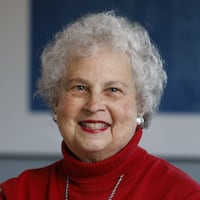But their footsteps changed history, and their lawsuit became the first test case in the north following the 1954 Brown v. Board of Education Supreme Court decision which had declared state laws establishing separate public schools for black and white students to be unconstitutional.
On Friday morning, Young — the only one of the five mothers who is still living — shared her story at the REACH conference at Sinclair Community College. Joining her were her daughters, and others involved in the struggle at the time.
REACH across Dayton is an annual get-together designed to create understanding and respect among those of different cultures and ethnicities.
“We need to know our stories and history and not forget the past,” said REACH coordinator Tess Little, explaining why the Hillsboro marchers had been invited to address the crowd.
Although the Supreme Court had already ruled school segregation to be illegal, the Hillsboro school board refused to comply. After the “colored” school in town burned down, some of the parents decided they didn’t want their children returning to the building.
“You know when you have a fire it weakens the structure and because of that I did not want my children to be in that school,” Young explained. “So we got together to try to get our children an education because nothing was being done for them that should have been.”
The panelists said the marches, which began in September 1954 and continued until April 1956, were necessary in order to file their lawsuit and prove that the black children were regularly showing up for school. After being turned away, the children would return to their homes each day to be home-schooled.
“As an 8-year-old, I didn’t really understand why we just didn’t go to Lincoln, (the black school), ” said Young’s daughter Virginia Harewood, who served as panel moderator. “We had to get up every morning and walk a mile — rain or shine — knowing that they weren’t going to let us in. I would fake sick, but you had to go. “
Now, she said, she is grateful to have had a mother who stood her ground.
“In 1954 and 1955, it was bad,” she added. “People were being killed for things they did then.”
Mary Steward, Young’s daughter-in-law, traced the various court cases and appeals that eventually led to the enforcement of integration in Hllsboro.
“As a result of our experiences, we don’t look at people as to their color, we look at people as human beings,” she said. “We’re grateful to be able to let our children know that things can more forward if you just keep pressing on.”
About the Author
